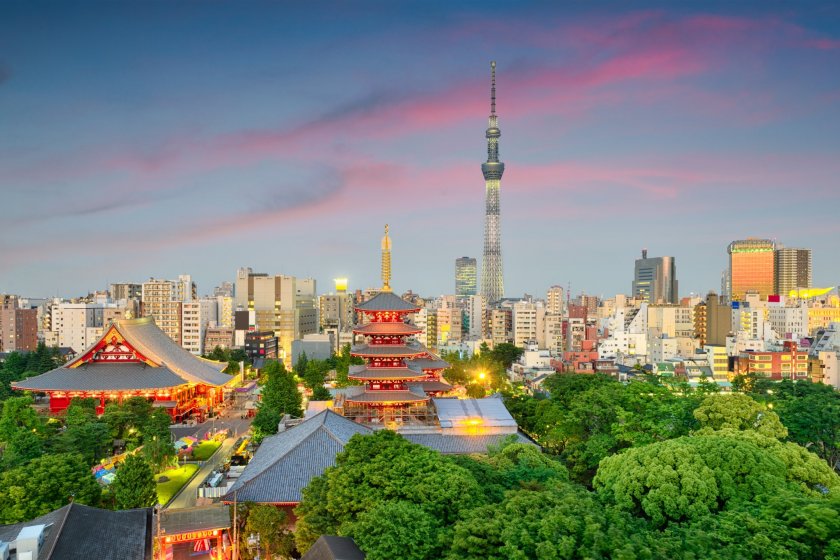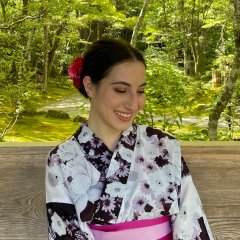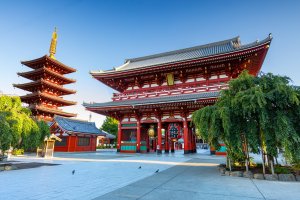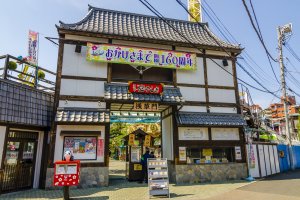Asakusa, located northeast of central Tokyo, is a district known for its old time atmosphere with a culture steeped in local tradition and history.
During the Edo period, the area was home to merchants and craftsmen working along the Sumida River. Today, Asakusa exudes the same charming vibes, leaving you with a displaced nostalgia for a past you never lived. Quaint food stalls and shops line the streets offering traditional cuisine and local wares, while rickshaws rattle by the district’s residents. The lively area will open your eyes to a different side of Tokyo, one that is distant from the modernization that has come to characterize the city and is a reminder of the strong roots that define Tokyo.
Whether you are grabbing a bite to eat at an izakaya on Hoppy Street, purchasing the perfect kimono on Nakamise Street, or strolling through the grounds of Senso-ji Temple, Asakusa is guaranteed to leave a lasting impression.
If you are planning a trip to Tokyo once borders reopen, be sure to stop by the historic district for a truly immersive experience. Asakusa is waiting for you with open arms.
Senso-ji Temple

Senso-ji Temple is the oldest and most famous temple in Tokyo, attracting 30 million visitors every year. The temple is a short five-minute walk from Asakusa Station and is free to enter. The temple grounds are always open, and the Main Hall is open year-round from 6:00 to 17:00 (opens at 6:30 from October to March). The vibrant red temple was founded in 628 when two fishermen fished a statue of Kannon, the goddess of mercy, out of the Sumida River. They attempted to return the statue to the river numerous times, but it kept reappearing in their net. The fishermen consulted the village headman and he converted his home into a temple to house the statue. Although the temple has 7th-century roots, the majority of its current buildings are relatively recent as the original structures were destroyed in bombings during World War II. Senso-ji’s reconstruction was funded by donations from all over Japan and, thus, stands as a symbol of Tokyo’s rebirth.
When you first approach the temple grounds you are greeted by Kaminari-mon, also known as Thunder Gate, which is an enormous red-and-green gate with an equally sizable lantern. Past the gate is Nakamise Street, which is bursting with food, clothes, and souvenirs. After perusing Nakamise Street, you will come across Hozo-mon Gate, which is the entrance to the main temple grounds and colored with the same vibrancy as Senso-ji’s other structures. Once you cross the threshold into the main temple area, the frenzied shopping atmosphere of Nakamise Street fades away and is replaced by a sense of sacredness. To the left of Hozo-mon is a colorful five-storied pagoda and tranquil garden; directly ahead is Kannondon, the Main Hall. The temple plays host to numerous festivals throughout the year such as Setsubun (Spring Celebration) and Hana Matsuri (Celebration of Buddha’s Birthday). For a unique perspective, visit the temple at night when the hallowed grounds are illuminated.
- 2-chōme-3-1 Asakusa, Taito City, Tōkyō-to 111-0032
- 6:00 - 17:00 (Closed now)
Nakamise Shopping Street

Nakamise Shopping Street, also called Nakamise Dori, is a staple in Asakusa and is the area’s most popular shopping street. The historic street, with origins dating to the 17th century, extends from Senso-ji Temple’s Kaminari-mon to Hozo-mon, which is the entrance to the main temple. Being located on the temple grounds, Nakamise Dori’s shops mirror the traditional design of Senso-ji with green-tiled roofs, red detailing, and bright lanterns. This 250-meter long area is lined with nearly 100 stores accompanied by colorful products, excited chatter, intoxicating aromas of food, and much more.
Nakamise Dori is renowned for its Asakusa- and Japanese-centered offerings, making it an ideal spot to pick up some souvenirs. You can purchase cultural wares such as kimono, chopsticks, sandals, katana, and fans, as well as delicious street food and local sweets. Try some ningyo-yaki, (cutely shaped sponge cakes filled with sweet bean paste) or kibi dango (sweet rice cakes covered with roasted soy bean flour). Although the street is often very busy, the conglomeration of residents and tourists alike adds to the animated atmosphere of the street. For an entirely different perspective, visit the empty street after hours and observe the shop’s shutters, which are painted with colorful cultural scenes. Most shops are open between 10:00 and 19:00. Nakamise Street is about a 3-minute walk from Asakusa Station.
View of Tokyo Skytree

While not located in Asakusa, Tokyo Skytree in nearby Oshiage is a notable landmark in the surrounding area and visible from the historic district. The television broadcasting tower stands at an incredible 634 meters tall, making it the tallest structure in Japan and the second tallest in the world! The Skytree is renowned for its two observation decks that provide stunning panoramic views of Tokyo. The iconic, narrow building is located across Sumida River, making Asakusa a popular spot to snap pictures of the tower among Tokyo’s skyline with the river in the foreground. Skytree is a feat of modern engineering with a visually intriguing facade characterized by thousands of crisscrossing exposed beams. During the day, the silver and metallic blue structure shines against the sky like a beacon of the future. At night, the scene transforms as Tokyo Skytree lights up like a rainbow with colors such as blue, red, and purple.
- 1-1-2 Oshiage, Sumida-Ku, Tokyo 131-0045 Japan
- 10:00 - 22:00 (Closed now)
- ¥500 - ¥4200
Hanayashiki Amusement Park

Hanayashiki is Japan’s first and oldest amusement park. True to its name, Hanayashiki, which roughly translates to “flower estate,” opened as a flower park in 1853. Today, the park is known for its classic retro rides and aesthetic, perfectly fitting the old-time feel of Asakusa. On a nice day, the excited chatter and adrenaline filled screams of guests fill the air, along with the delicious smells of Japanese fast food. Of course the main lure of the amusement park is its rides! Hanayashiki is home to the country’s oldest steel track roller coaster, which was built in 1953 and reaches a maximum speed of 42 km per hour. Another popular ride is the Bee Tower. This tall structure brings you up 45 meters and provides scenic views of Asakusa, as well as the Tokyo Skytree.
Hanayashiki also includes amusement park staples such as a merry-go-round, ferris wheel, a drop ride called Space Shot, a spinning ride called the Disk “O,” and many more. Apart from the rides, you can also creep through an Edo-inspired haunted house, navigate ninja obstacle courses, watch a 3D movie, and pose in photo booths to print custom stickers. Another adorable feature of the amusement park are its Panda Cars, which are personal plush panda-shaped cars that you can drive around the park! After hours of adventuring, refuel with delicious tempura, ramen, takoyaki, hot dogs, or crepes. The park also has a Dom Dom Hamburger on-site, which is Japan’s oldest burger chain and serves the famous Asakusa croquette burger.
Hanayashiki is about a 10-minute walk from Asakusa Station and only a 1-minute walk from Senso-ji Temple. Visitors must pay an admission fee to enter the park, as well as purchase tickets to enjoy the rides. For all day fun, the park offers Free Ride Passes, which allow users to ride unlimited rides. Prices vary depending on age.
Asakusa Culture Tourist Information Center Observation Deck

Do not pass up this seemingly simple informational building. While the first floor is dedicated to tourism information and guidance, the top eighth floor has a free open terrace observation deck with stunning views of Asakusa, as well as Tokyo beyond. The distinctive building is a short 3-minute walk from Asakusa Station and hard to miss due to its unique architectural style. Designed by famed architect, Kengo Kuma, the structure’s exterior consists of thousands of wooden beams contrasted against sleek glass and has the appearance of multiple wooden houses stacked on top of one another. In addition to the observatory, the eight floor also has a small cafe that sells light meals, snacks, and refreshments. From the observatory, you are treated to panoramic views of the historic district with Senso-ji Temple, Kaminarimon, and Nakamise Shopping Street to the north and Tokyo Skytree to the east. At nighttime, the scenes transform as Senso-ji Temple lights up and the Tokyo Skytree is illuminated with a rainbow of colors. The Tourist Center is open from 9:00 to 20:00, and the observation deck closes at 22:00.
Ride on a Rickshaw

Rickshaws, or jinrikisha, originated in Japan around the 19th century as a means of transportation. The man-powered vehicles are usually characterized by their two-wheeled, chair-like appearances and can hold one to three people. Given the rickshaw’s traditional origins, it is appropriate that they are still commonplace in charming Asakusa. Though today, they are primarily used for tourism purposes. Climb aboard a rickshaw and explore the picturesque streets of Asakusa. For a truly immersive experience, rent a kimono as you ride through the neighborhood. The friendly rickshaw pullers are extremely informative and act as guides, providing interesting facts about the area, as well as fun photo spots. Fortunately, there is no shortage of rickshaw establishments and reservations are not always required. Though they can be helpful for longer and more customized rides. Sit back and enjoy the ride!
Sumida Park and Sumida River Cruises

Sumida Park runs along both sides of the Sumida River and is about a 5-minute walk from Asakusa Station on the Asakusa side. This small, nature-touched getaway is a wonderful spot to slow down after exploring the district’s busy streets. Stroll along the water or rest your feet at a small cafe with a beer or coffee and enjoy views of the Sumida River, Tokyo skyline, and Tokyo Skytree. During spring, the park blooms with hundreds of cherry trees, making it a beautiful spot to observe the pastel flowers. At night, the park illuminates the trees, creating a magical viewing experience. Sumida Park is also a prime location during summertime to watch Tokyo’s annual firework displays.
While standing onshore, you will likely see boats cruising along the Sumida River. Boat travel is a practical and scenic way to visit Tokyo’s other districts. Bypass the congested streets of the city and enjoy a leisurely ride complete with magnificent views of Tokyo. There are a host of boating companies ready to travel the waters such as Tokyo Cruise, Tokyo Mizube Cruising Line, and Tokyo Water Taxi. One Tokyo Cruise Pier, which has ferry departures on a daily basis, is conveniently located beside Sumida Park and a 3-minute walk from Kaminarimon. Whether viewing from a distance or traversing the clean waters, Sumida River is a wonderful natural landmark to enjoy.
Kappabashi Street

Foodies, chefs, and aspiring cooks will not want to pass up this unique street! Kappabashi, located between Ueno and Asakusa, is a shopping street lined with dozens of cooking-themed stores, selling everything from cooking utensils to dishes to plastic food replicas. The shopping area is a short 10-minute walk from Senso-ji Temple and hard to miss thanks to the enormous bust of a chef that sits atop Niimi, one of the corner stores. The street is a wonderful place to pick up souvenirs or purchase items to enhance your own cooking experiences back home. Take time to peruse the endless ceramic dishes, bamboo products, Japanese knives, bento boxes, kitchen gadgets, and much more. Pick out the perfect pair of chopsticks as a memento of your trip. If you get hungry after browsing through all the food-related wares, stop by Kappabashi Coffee Shop to refuel with some caffeine and a sandwich or slice of cheesecake.
Sanja Matsuri

Sanja Matsuri is one of Tokyo’s most popular festivals and held annually on the third full weekend of May. The chaotic festival is known for its frenzied energy as nearly two million people pack into Asakusa to observe and partake in the festivities. Sanja Matsuri celebrates the three founders of Senso-ji Temple, who are enshrined in the nearby Asakusa Shrine. The festival starts on Friday with a parade of priests, city officials, geisha, musicians, and Edo-period clad dancers who walk along Yanagi Dori to Asakusa Shrine. Afterward, neighborhood residents carry mikoshi, or small portable shrines, through the streets. On Saturday, the mikoshi truly shine when Asakusa’s neighborhoods bring nearly 100 portable shrines to Senso-ji Temple and Asakusa Shrine to be blessed before parading around the district’s streets to spread good fortune and prosperity to businesses and residents. The festival ends Sunday when, after some competitive jostling, a selected few festival goers carry Asakusa Shrine’s three main mikoshi throughout the district. The contagious energy of Sanja Matsuri is palpable and represented not only in the festival’s ceremonies, but in the aromatic food stalls, festival games, and ever-present traditional music.
Hoppy Street

After some spiritual rejuvenation at Senso-ji Temple, why not indulge in a different kind of healing? Hoppy Street, named after the nearly non-alcoholic beer, is a famous drinking-and-eating area lined with dozens of inexpensive izakaya, or casual Japanese bars, and is only a 2-minute walk away from Senso-ji Temple. The collection of lantern-decorated establishments, busy outdoor seating, and lively chatter create a cheerful atmosphere that epitomizes Asakusa’s nightlife. Try the area’s signature drink of Hoppy mixed with shochu. The light flavor of Hoppy, which has a low alcohol content (0.8%), balances perfectly with the stronger distilled alcoholic bite of the shochu. The street has also earned the nickname Stew Street as most of the izakayas sell their own variations of nikomi, which is a soy sauce based stew made with beef tendon and vegetables. So, be sure to pair your Hoppy drink with a warm bowl of stew!
Suzukien

Suzukien, located a short 3-minute walk from Senso-ji Temple, is an over 150 year old tea shop that is world renowned for its matcha-flavored gelato. The shop partnered with Nanaya, a matcha sweets factory in Shizuoka, to bring rich gelato to the streets of Tokyo. Stop by Suzukien and try one (or more) of its seven levels of matcha-flavored gelato. No. 7 is said to contain the richest matcha flavor in the world with a taste that is rich in green tea without being overly bitter. Take a bite and transport your taste buds to the lush tea fields of Shizuoka’s countryside. Suzukien recommends that customers purchase No. 1, or another less intense level, alongside the No. 7 gelato, to compare the variations in flavor. Aside from matcha, Suzukien also sells other traditional Japanese gelato flavors such as hojicha (roasted tea), genmaicha (tea with grains), black sesame, and dainagon azuki (a type of sweet red bean). After enjoying the creamy treat, browse through the tea-related merchandise, including green tea whisks, teapots, and loose leaf teas. If you are a tea lover, specifically a matcha enthusiast, Suzukien is a must visit.






































